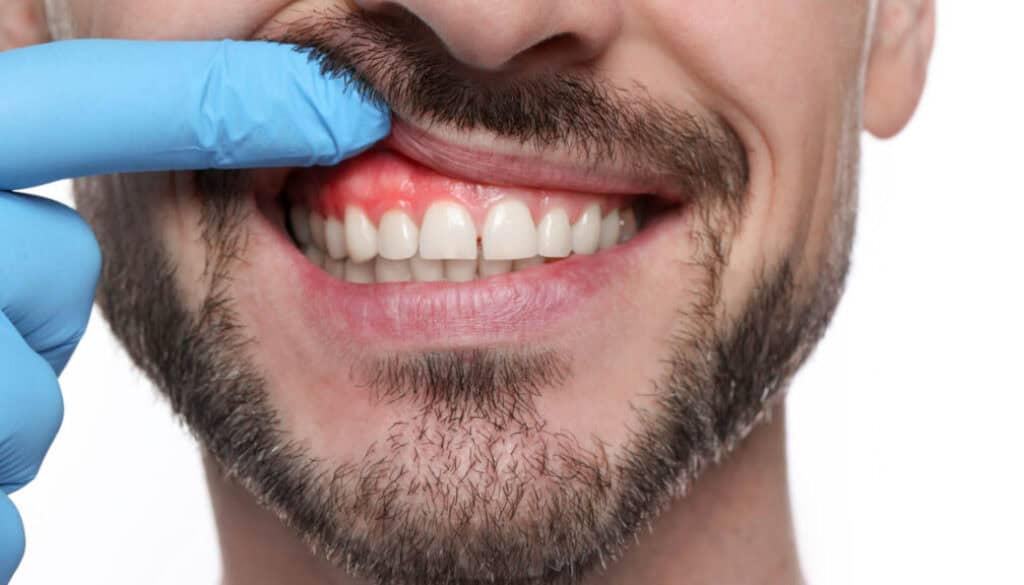Healthy gums are usually pink, firm, and moist, reflecting good blood circulation and overall oral health. When your gums start to appear pale, white, or discoloured, it may be your body’s way of signalling an underlying issue. Pale gums can occur for several reasons, some minor and easily treatable, while others may indicate more serious health concerns.
The colour of your gums depends largely on blood flow and the number of red blood cells in your body. Reduced blood flow or low haemoglobin can make gum tissues look pale. Poor oral hygiene, infections, and systemic illnesses can also contribute to this discolouration.
Understanding the causes early helps prevent complications like gum recession, tooth loss, or even oral cavity cancer. At Chrysanth Dental, our experienced dentists emphasise regular dental check-ups to identify such changes early. Early detection ensures appropriate treatment and a confident smile.
Common Causes of Pale Gums
Anaemia and Reduced Red Blood Cells
Anaemia is one of the most common causes of pale gums. When your body lacks sufficient red blood cells or iron, less oxygen reaches your gum tissue, leading to a lighter appearance. Iron deficiency anaemia may also cause fatigue, pale skin, and dizziness. A simple blood test can confirm this condition, and treatment often involves iron supplements or dietary adjustments. Foods rich in iron like leafy greens, beans, and lean meats can help restore normal gum colour over time.
Poor Oral Hygiene and Gum Disease
Neglecting proper brushing and flossing encourages dental plaque overgrowth, leading to gum inflammation and eventual discolouration. In its early stages, gum disease (gingivitis) causes redness and swelling, but in more severe cases, the gums may appear pale and recede from the teeth. Maintaining good oral hygiene including twice-daily brushing with fluoride toothpaste, flossing, and using an alcohol-free mouth rinse is essential for preventing pale gums and other oral health issues.
Oral Thrush and Fungal Infections
A fungal infection such as oral thrush can lead to white or pale patches on the gums, tongue, or inner cheeks. This condition is caused by the overgrowth of Candida yeast and is common in individuals with weakened immune systems or after antibiotic use. Treatment typically includes antifungal medication and improved oral care. Severe cases may require medical treatments and dietary adjustments to restore healthy oral balance.
Oral Lichen Planus and Autoimmune Conditions
This chronic autoimmune condition affects the mouth’s mucous membranes, causing white patches, sores, or pale gums. The body’s immune response mistakenly attacks healthy tissues, leading to sensitivity and inflammation. Treatment involves managing symptoms using corticosteroid treatments, maintaining good oral hygiene, and avoiding triggers like tobacco products and spicy foods.
Symptoms That Accompany Pale Gums
Pale gums rarely appear alone. Other symptoms may indicate the severity of the issue including mouth sores or canker sores, white patches or surface stains on gum tissue, bad breath (halitosis), loose teeth or gum recession, bleeding while brushing or flossing, swollen gums or tenderness, and changes in gum texture. These symptoms suggest that your oral health may be compromised, and you should book an emergency appointment with a dental professional if they persist.
When Pale Gums Signal Serious Health Problems
In some cases, pale gums may point to underlying health problems such as oral cancer, autoimmune diseases, or systemic infections. Gums turning pale with white lumps, chronic bleeding, or persistent ulcers require immediate evaluation. Developing oral cancer can manifest as pale gums, white or red patches, and pain that doesn’t resolve. Routine screenings at Chrysanth Dental can detect early signs, improving treatment outcomes. If pale gums appear suddenly after tooth extraction, dental implants, or trauma, it might indicate restricted blood flow or infection. Contact your dentist right away for proper treatment.
Diagnosing Pale Gums
Blood Tests and Oral Examinations
A dentist begins with a visual oral examination to assess gum colour, swelling, and texture. If anaemia or systemic illness is suspected, a blood test checks red blood cell count, haemoglobin, and iron levels.
Imaging and Biopsy in Severe Cases
In severe cases, when oral cancer or lichen planus is suspected, imaging or biopsy may be recommended. Early diagnosis ensures timely intervention and prevents complications such as eventual tooth loss or gum tissue damage.
Treatment Options for Pale Gums
Professional Dental Treatments
If poor dental hygiene is the cause, a professional cleaning helps remove plaque and tartar. Scaling and root planing can restore gum health by reducing bacterial infection. For tooth decay or missing teeth, options like dental implants or restorative treatments may be advised.
Medical Treatments and Supplements
For systemic issues like anaemia, iron supplements and dietary changes are key. For fungal infections, antifungal gels or lozenges can be prescribed. In autoimmune conditions, corticosteroid treatments may be needed to control inflammation.
Home Remedies and Preventive Measures
Salt water rinses help reduce bacteria naturally. Use a soft-bristled toothbrush to protect sensitive mouth tissues. Avoid tobacco products and limit alcohol. Follow a balanced diet to support overall health. Keep up with regular dental check-ups every six months.
Maintaining Good Oral Health
Proper Brushing and Flossing
Brushing with fluoride toothpaste and flossing daily are fundamental to maintaining good oral hygiene. Replace your toothbrush every three months and use an alcohol-free mouth rinse for added protection.
Nutrition and Lifestyle Habits
A balanced diet rich in vitamins C and D and iron supports gum strength. Avoid sugary foods, stay hydrated, and limit caffeine intake. Remember, your oral health reflects your overall health as both are deeply connected.
FAQs about Pale Gums
1. Are pale gums always a sign of disease?
Not necessarily. Temporary paleness may occur due to mild irritation or poor circulation, but if it persists, consult your dentist.
2. Can pale gums go away on their own?
If caused by minor irritation, they may improve with better hygiene. However, persistent pale gums need professional evaluation.
3. What’s the difference between pale gums and white gums?
Pale gums usually indicate low blood flow or anaemia, while white gums may point to fungal infections or oral lichen planus.
4. How can I prevent pale gums?
Maintain good oral hygiene, eat a balanced diet, and attend regular dental check-ups.
5. When should I see a dentist about pale gums?
If pale gums are accompanied by pain, swelling, or mouth sores, schedule an emergency appointment with Chrysanth Dental.
6. Are pale gums linked to oral cancer?
Sometimes, yes. Developing oral cancer can present as pale or white patches. Early screening is crucial for successful treatment.
Conclusion
Pale gums may seem harmless, but they can be early signs of gum disease, anaemia, or oral infections. Maintaining good oral health through consistent care, regular check-ups, and a balanced diet can prevent most causes. If you’ve noticed your gums turning pale or white, don’t ignore the warning. Contact Chrysanth Dental today to schedule a comprehensive examination and receive a personalised treatment plan from our experienced dentists. Your smile deserves the best care possible.
Disclaimer: This article is intended for general informational purposes only and should not be used as a substitute for professional dental advice, diagnosis, or treatment. Always consult a qualified dentist or healthcare provider regarding any concerns about your oral health.




